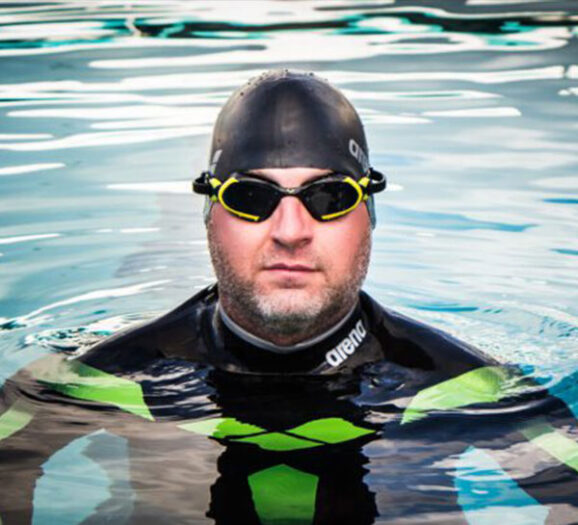
JUST PUBLISHED: Will the Great Icelandic Swim break Ross Edgley?
In 2018, British adventurer Ross Edgley became the first person ever to swim around the coast of Great Britain, a 1,780-mile journey that he described as going from “a swim as most people consider it, as a sport, to being a survival exercise.”
He’s also achieved other headline-grabbing feats including pulling a 1,400kg Mini Cooper during a marathon and climbing the equivalent height of Everest on a rope in under 20 hours.
But now, the 39-year-old is about to embark on a challenge that I think will prove much, much harder than anything he’s done before: the Great Icelandic Swim.
On 16th May, Edgley will dive into freezing Arctic waters off Iceland’s coast to begin an unprecedented solo 1,000-mile lap around the frigid island. It will take three months, with him planning to cover 30 nautical miles per day.
And there’s more to his attempt than just glory. Edgley has framed the Great Icelandic Swim as a citizen science mission to find out more about the impact of climate change and man-made pollution on the ocean waters and marine life it supports.
Travelling with a 68-foot support yacht and rotating crew, he plans to collect daily water samples to monitor microplastics, marine biodiversity and chemical pollutants like flame retardants. Academic partners, including the University of Iceland and the Marine and Freshwater Research Institute, will analyse the data. The team also hopes to log sightings of whales and other ocean life, while monitoring Edgley’s own physiology to assess the impact of prolonged cold-water exposure on the human body.
If he succeeds, then, he’ll both make history and contribute to our scientific knowledge. The question, though, is will Iceland prove a step too far, even for him?
Yes, Iceland’s 1,000-mile swimming route may be shorter than going around Britain.
Yes, it’s being done in the name of science and is all very noble.
But let’s not forget that it’s an achievement that’s remained unclaimed for a good reason: the waters there are colder, rougher and far less forgiving. Immersed in Iceland’s coastal waters, which can be as low as 6 °C, for up to 12 hours a day, he’s at constant risk of hypothermia not to mention severe injury and crippling fatigue.
And as someone who has taken on an ocean challenge, attempting to become the first person in history to swim across the Atlantic Ocean, I can say with absolute authority that the threat of the cold cannot be underestimated.
Cold shock and limb incapacitation will hit hard at the start of each daily swim, especially in the early weeks before his body has properly adapted. And while he’s in the water, his core temperature will drop dangerously low, significantly increasing the risk of organ dysfunction and unconsciousness.
Even after leaving the water and back on deck, he’s still not out of danger as there’s the risk of an ‘after-drop’ — a further dip in body temperature as cold blood from the limbs returns to the core — occurring.
Cold shock and limb incapacitation will hit hard at the start of each daily swim, especially in the early weeks before his body has properly adapted. And while he’s in the water, his core temperature will drop dangerously low, significantly increasing the risk of organ dysfunction and unconsciousness.
Even after leaving the water and back on deck, he’s still not out of danger as there’s the risk of an ‘after-drop’ — a further dip in body temperature as cold blood from the limbs returns to the core — occurring.
And that’s before you factor in the sheer wear and tear of his endeavour. Salt water and friction can take a swimmer out long before they’re physically exhausted. In 2018, on the Great Britain swim, his tongue literally began to disintegrate, his neck hardened with salt plaques, and the arches of his feet collapsed. I had similar issues during my Atlantic crossing. I managed them with mouthwash, barrier creams, and constant skin care. Edgley needs to do the same, especially when it comes to heel fissures. They’re painful, slow to heal, and dangerous if left untreated.
By week three or four, shoulder strain and swelling in the wrists are also likely. The only way through that is strict load management and physiotherapy support on deck. Hopefully he’ll have both.
There’s also the mental aspect to consider. Edgley is good at playing to the camera, and there’s no doubt he thrives in the spotlight. But out there, in the water, none of that matters. Monotony, fatigue and lack of sleep are hard to fight. Having a crew and yacht will help, but what really makes the difference are the routines: visualising the next checkpoint, breaking the day into blocks and resting properly. Without that order, things start to unravel quickly.
Ultimately, success won’t come down to hype or heroics but will entirely depend on whether the systems that Edgley and his team have put in place — physically, logistically, mentally — can hold up under pressure, day after day. That’s what separates a good expedition from a survivable one. And in a place like this, with cold, salt and time all working against you, survival is the real benchmark.
I wish Ross and his crew well. I know just what it’s like to push past limits in open water and I’ll be watching his progress, like so many others, with keen interest.

